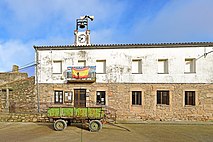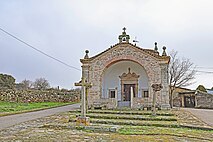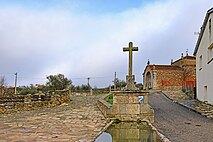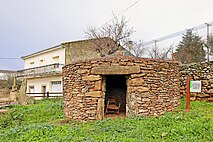Vermellar
Bermellar is a Spanish municipality and town in the province of Salamanca, in the autonomous community of Castilla y León. It is integrated within the Vitigudino region and the sub-region of El Abadengo. It belongs to the judicial district of Vitigudino.
Its municipal area is made up of a single population center, it occupies a total area of 28.46 km² and according to the demographic data collected in the municipal register prepared by the INE in 2017, it has a population of 136 inhabitants.
Toponymy
The origin of the place name Bermellar would be found, according to the theory of Professor Antonio Llorente Maldonado, in the reddish color of the land where it sits ("bermeyu" in the Leonese language). However, in the opinion of Pascual Riesco, Chueca would be equivalent to the old Portuguese place names «Marmelar» (XIII century) or «Marmelal» (1265), which allude to the "quince" tree ("la marmiellal" in the Leonese language, from the Latin "melĭmēllum"), and could also be compared to the Burgos place names Marmellar de Abajo and Marmellar de Arriba. The latter appears documented in 950 as "Malmellare", thus confirming its relationship with "melĭmēllum". It is also worth mentioning the name of the depopulated area of "Marmellar", also in the province of Burgos, documented in the same way in 1011. As reinforcement of this hypothesis, we can mention the fact that in 1421, a Benito Pérez is indicated in Ciudad Rodrigo of "Mermellar", probably originally from the town.
Geography
Bermellar is located in the northwest of Salamanca. It is 90 km from Salamanca capital.
It is integrated into the region of El Abadengo. It belongs to the El Abadengo Mancomunidad and to the judicial district of Vitigudino.
Its municipal area is located within the Arribes del Duero Natural Park, a protected natural area of great tourist attraction.
| Northwest: Saucelle | North: Barruecopardo | Northeast: Saldeana |
| West: Hinojosa de Duero |  | This: Cerralbo |
| Southwest: Lumbrales | South: Lumbrales | Sureste: Olmedo de Camaces |
The terrain is broken and rocky, with microclimates where a type of Mediterranean vegetation thrives on some slopes and Atlantic on others, populated by fauna of great ecological interest. Practically the entire territory is Arribes del Duero Natural Park. Las Arribes de Bermellar stands out for its important landscape and ecological value in the impressive canyons that the Huebra River has forged over time.
In the term, and especially in the named arribes, you can see a wide variety of birds, among other fauna, most of them protected for their uniqueness as is the case of the black stork, Egyptian vulture, eagle owl, golden eagle, Bonelli's eagle, red kite and peregrine falcon. Less unusual, the populations of red-billed chough and white stork stand out.
The characteristics of the population mean that it has an important tourist value that has caused an incipient birth of rural tourism businesses, although most of its resources are still unexploited.
History
Since ancient times, the primitive Celtic population built a fortress over the Huebra River, the castro de Saldañuela, of which interesting vestiges still remain. The subsequent arrival of the Romans would impose new guidelines and ways of life on the native communities. Bermellar would know, thus, the passage of antiquity.
In the XII century it became dependent, along with the rest of the Abadengo, on the Order of the Temple by order of the king Fernando II de León, a situation that lasted until the disappearance in 1311 of said Order by papal mandate, when Bermellar became dependent on the Bishop of Ciudad Rodrigo, on whom it depended until the abolition of the lordships in the XIX. With the territorial division of Spain in 1833 in which the current provinces are created, Bermellar is framed within the Leonese Region, formed by the provinces of León, Zamora and Salamanca, of a merely classificatory nature, without administrative operation, which in broad strokes It would come to collect the old demarcation of the Kingdom of León (without Galicia, Asturias or Extremadura), becoming part of the judicial district of Vitigudino in 1844.
Demographics
According to the National Statistics Institute, as of December 31, 2018, Bermellar had a total population of 132 inhabitants, of whom 66 were men and 66 women. Regarding the year 2000, the census reflects 222 inhabitants, of which 109 were men and 113 women. Therefore, the loss of population in the municipality for the period 2000-2018 has been 90 inhabitants, a 41% decrease.
| Figure of demographic evolution of Bermellar between 1842 and 2021 |
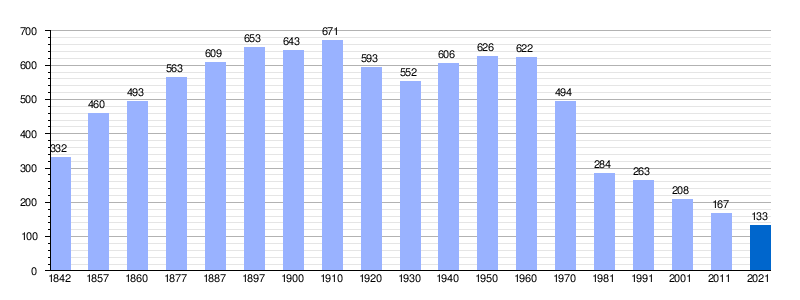 |
Rule population (1842-1991, except 1857 and 1860 which is a de facto population) or resident population (2001-2011) according to the Population Censuses since 1842.Population according to the municipal register of 2021 of the INE. |
Administration and politics
Municipal elections
| Political party | 2019 | 2015 | 2011 | 2007 | 2003 | ||||||||||
|---|---|---|---|---|---|---|---|---|---|---|---|---|---|---|---|
| % | Votes | Councillors | % | Votes | Councillors | % | Votes | Councillors | % | Votes | Councillors | % | Votes | Councillors | |
| Spanish Socialist Workers Party (PSOE) | 50.43 | 59 | 3 | 54.17 | 78 | 2 | 50,00 | 78 | 2 | 56.79 | 92 | 2 | 45,06 | 73 | 1 |
| Popular Party (PP) | 47,86 | 56 | 2 | 30.56 | 44 | 1 | 44,87 | 70 | 2 | 41,98 | 68 | 1 | 53,70 | 87 | 4 |
| Citizens (Cs) | - | - | - | 50.69 | 73 | 2 | - | - | - | - | - | - | - | - | - |
| SI Coalition for Salamanca (SI) | - | - | - | - | - | - | 47,44 | 74 | 1 | - | - | - | - | - | - |
| Union of the Salmantino People (UPSa) | - | - | - | - | - | - | - | - | - | 57.41 | 93 | 2 | - | - | - |
The mayor of Bermellar does not receive any type of financial benefit for his work as head of the town hall (2017).
Heritage
- The parish church of Santa Maria Magdalena.
- Chapel of the Holy Christ.
- Castro de Saldañuela.
Contenido relacionado
Choiseul district
Economy of the Netherlands Antilles
The bodon


